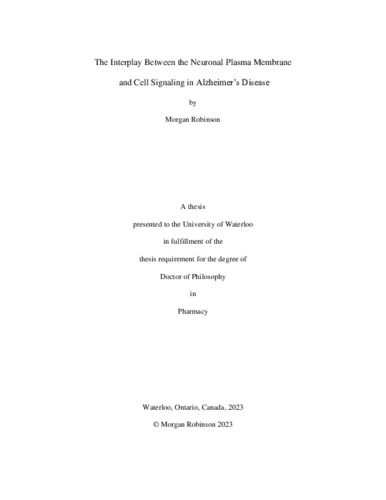| dc.description.abstract | The lack of understanding in the molecular and cellular mechanisms of Alzheimer’s disease (AD) has hindered efforts towards finding treatments that effectively modify disease trajectory. Therapeutic development for AD has focused on targeting amyloid-β (Aβ) pathology, long thought to be the cause of AD pathogenesis, but these have failed in clinical trials. Aβ is a sticky aggregation-prone protein that disrupts membrane structure and interferes with specific receptors in the brain, impairing synaptic plasticity, an important process for learning and memory, and eventually causes cell death. The interplay between disruption of the neuronal membrane and neuronal receptors in AD overlaps with inflammation and oxidative stress in a feedback loop that makes it difficult to ascertain the causes and effects of AD. More recent genetic and epidemiology data indicates that lipid metabolism is critical in AD pathogenesis, underscoring the need to understand how brain lipid composition (especially cholesterol) in brain affects amyloid toxicity. In the first part of this work the relevant background literature of lipid mediated mechanisms of AD is discussed and an overview of methods used herein are provided.
In the second part, the results of biomedical nanotechnology experiments where atomic force microscopy (AFM) was used to study interactions of supported lipid bilayers (SLBs) with melatonin and Aβ at the molecular level. Chapter 3 shows the characterization of biophysical changes that melatonin induces in SLBs of DOPC/DPPC/Cholesterol by AFM and atomic force spectroscopy (AFS). Overall, AFM imaging revealed that melatonin increases disordered domain coverage, reduces bilayer thickness and indentation depth, increases membrane fluidity, and decreases membrane adhesion, though large variability was observed. In Chapter 4, for the first-time contact mode high-speed AFM (HS-AFM) was shown to be able to image lipid membranes of different compositions. HS-AFM was used to capture large areas of membranes comparing the effects of Aβ monomers and oligomers to different phase separated lipid bilayers composed of low and high cholesterol showing different interaction mechanisms.
In the third part of this thesis the influence of membrane composition and amyloid toxicity on HT22 neuronal cell viability, cholesterol metabolism, morphology, and receptor tyrosine kinase (RTK) signaling pathways was elucidated. Beginning in Chapter 4, cholesterol oxidase assays and AFM verify cell cholesterol content reduction and Aβ structure, respectively. There was no effect of Aβ on cholesterol recovery and cell viability studies show that cholesterol depletion was modestly protective against both Aβ monomers and oligomers. In Chapter 5, the cholesterol-dependent effects of Aβ monomers and oligomers on HT22 cell morphology by phase contrast optical microscopy and atomic force microscopy (AFM) reveal apoptotic and necrotic populations of HT22 cells exposed to Aβ and that that membrane cholesterol depletion prevents these changes in morphology. In Chapter 7, the effects of cholesterol and Aβ on baseline Tyrosine Receptor Kinase B (TrkB) receptors and PDGF receptor-α (PDGFRα) signaling, reveal that RTK signaling is cholesterol-dependent and that high concentration Aβ oligomers increase the likelihood of RTK impairment, but there was no statistically significant effect of Aβ on PDGFRα signaling.
This work provides experimental evidence that membrane cholesterol is not strongly involved in the mechanisms of Aβ toxicity in HT22 cells, but its reductions may be mildly protective. RTK signaling in HT22 cells is impaired by Aβ but is not involved in the protective mechanisms of cholesterol depletion. Aβ disrupts membrane biophysical structure and receptor signaling pathways triggering metabolic dysfunction and both apoptotic and necrotic cell death mechanisms. | en |

